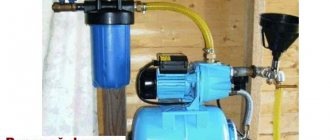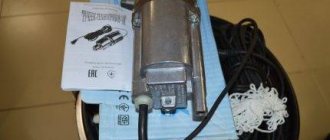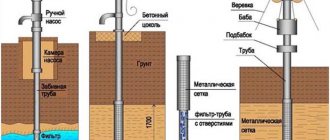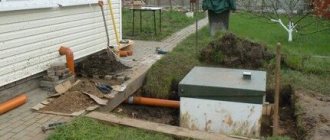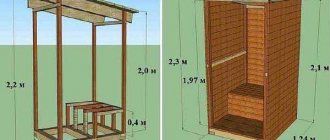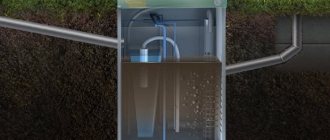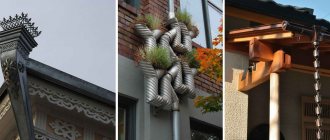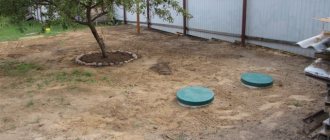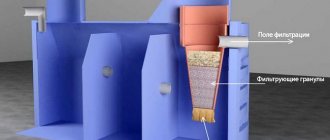Drainage trays are used in surface drainage systems. The purpose of the tray in this case is to collect water and then send it to the water intake. Trays are usually installed along curbs, under drains or at the end point of a circular blind area.
This article will discuss the main types of trays, the materials used for their manufacture, the installation of drainage trays and recommendations for choosing the most suitable design.
Drainage trays: 10 tips for selection and installation
Water wears away stones. The meaning of this expression is especially clearly understood when you take on construction work yourself, in particular the arrangement of the foundation or local area. If the drainage system is not properly organized, then rain and melt water, accumulating in an unintended place, will act destructively. As a result, the foundation may suffer, as well as the materials used to cover roads, parking lots, local areas, etc. Selecting drainage trays and installing them is not so difficult, so this stage of work should never be neglected.
How does the drainage system work?
A drainage system is a system for collecting and draining rain, melt and groundwater to a specially designated place. Drainage systems are divided into the following types:
- surface - those through which rain and melt water are collected and later transported to storm sewers;
- deep - designed for collecting and draining groundwater.
Drainage trays are part of a surface drainage system. In addition to them, storm water inlets and sand traps are used. As a rule, a drain drains water into a storm drain, a regular sewer system or a pond, but some enterprising summer residents direct the collected water to the beds. This is a practical solution, but it will be justified if there are heavy rainfalls - this is very rare in the region, otherwise a strong flow of water can wash out the soil and harm the plants.
Trays are made from different materials. Typically plastic, concrete and metal are used. It is advisable that the top of the tray be covered with a grill, which protects the system from large debris and, consequently, from clogging. The tray can be U- or U-shaped. When choosing a drainage tray, first of all, attention is paid to the material of its manufacture, therefore we will start with this characteristic.
Do-it-yourself drainage of the area around the house
If the distance is less than 1.5 m, then the bearing capacity of the soil decreases - it becomes waterlogged and saturated with water. This affects the settlement of the foundation and makes the construction of a basement or ground floor problematic.
To drain the area around the perimeter of the planned house, or better yet along the edges of the entire yard, they dig channels with a slight slope and organize drainage. The optimal width of such channels is 50-70 cm.
The depth is calculated in each case individually, since it depends on how much the groundwater level needs to be lowered. Drainage is laid as follows.
At a distance of 2-3 m from the house, dig a ditch with a depth equal to the base of the foundation. A 15-20 cm layer of clay is placed on its bottom, giving it the shape of a tray. Medium-sized stones are carefully laid on top, forming sides. Large stones are placed on top, forming a vault. Gravel or crushed stone 25-30 cm high is placed on it. Everything is covered with soil removed during excavation. Water will seep through the soil into the tray and flow in the desired direction.
Plastic drainage trays
Plastic trays are made from polypropylene and low-density polyethylene. In private construction they have gained the greatest popularity. Products differ in width (7-30 cm). To increase strength properties, stiffeners can be used. Such reinforced gutters are perfect for arranging areas near garages, parking lots and car service stations.
Pros:
- price. Plastic trays are cheaper than all analogues;
- light weight, which ensures ease of transportation and installation;
- resistance to silting, since the surface of the tray is absolutely smooth;
- resistance to low and high temperatures, from -40 to +900C;
- relatively high resistance to aggressive substances that may enter the drain
Minuses:
- low strength, low resistance to mechanical loads, which imposes restrictions on the area of use.
Such products are perfect for arranging the territory of a country house, but if we are talking about a road or an industrial area, then it is better to take more reliable material. An alternative solution is to reinforce the plastic tray with a zinc plate. Otherwise, during a strong flood, such a gutter may be deformed or even moved out of place.
The plastic tray must be protected with a grate, otherwise the storm drain may become clogged with debris flowing from the area. The grate should be light, but at the same time durable. Products made of galvanized or stainless steel are ideal. The strength of the grating is chosen depending on where the drain is installed, since the loads will be different near a country house and a car service center.
Cast iron
In the production of cast iron trays, two grades of cast iron are used:
- cast iron with lamellar graphite grain;
- cast iron with spherical graphite grain.
This material is part of the product profile and its lattice. Considering the fact that cast iron is very susceptible to corrosion, finished structures are galvanized, but usually this procedure is performed optionally: the client can order a tray without a zinc coating.
Since cast iron has good resistance to longitudinal and transverse loads, products made from it are used in places where they will be subject to great forces.
Typically, cast iron trays are installed on runways, truck stops and other areas: the use of cast iron trays on private land is not justified from a financial point of view. Dimensions of typical cast iron products:
- length – no more than 0.5 m;
- width – no more than 0.2 m;
- lattice thickness – from 0.05 m;
- internal diameter – from DN 100.
Metal drainage tray
Metal makes the most durable products. Despite this undeniable advantage, such gutters are currently used extremely rarely. The main reason is susceptibility to corrosion. Of course, manufacturers apply a protective layer, but it does not always prevent rust, since the product will be in constant contact with water. In addition, metal is expensive, and everything about such gutters will be decent, which will significantly complicate independent installation.
Metal trays can be of the following types:
- cast iron. They are used extremely rarely due to their high weight. But they have practically no analogues in strength. Such products are not used in private construction, but they can be seen at military bases and other military facilities;
- steel trays (stainless and galvanized) are slightly inferior in strength to cast iron ones, but when choosing the right size and proper installation, such gutters serve no worse. On the other hand, they are much lighter than cast iron, which means they are easier to install. The products are used for arranging park areas and roads where passenger cars travel.
When choosing, it is important to pay attention to the thickness of the metal, as well as the thickness of the protective layer, on which strength and durability directly depend.
Preparing to make a gutter
When manufacturing a device for transporting concrete, the following must be taken into account:
- The structure must connect the concrete mixer container with the formwork of the future foundation.
- It must be at a certain angle, which will allow the mixture to flow freely under the influence of its own weight to the desired location.
To make the structure you will need the following tools:
- Hacksaw or saw.
- Yardstick.
- Bulgarian.
- Hammer.
- Square.
- Screwdriver.
Materials to be prepared:
- Edged board 25x120 mm.
- Nails or screws.
- Linoleum, tin or plastic film.
- Blocks or timber for supports.
Formwork diagram.
In addition, when starting the manufacturing process, you should take into account several basic rules that impose special requirements on devices of this type. Thus, the manufactured gutter along its entire length must have a constant level of slope. If the slope decreases, the flow of the concrete mixture may slow down, which will then lead to clogging or premature hardening of the concrete. If the slope of the device, on the contrary, increases and pouring begins to be carried out faster, the concrete solution may disintegrate into separate parts, which will inevitably lead to a deterioration in the quality of the mixture. The base of the foundation will lose its reliability and will be short-lived.
When creating a gutter, the level of its taper should be calculated based on the degree of delivery distance of concrete, as well as its consistency. Liquid mixtures that the mixer delivers over short distances allow for small slopes. If the mixtures are quite thick or are supplied over significant distances, then the gutters should be as steep as possible.
The preservation of the homogeneity of the concrete mixture is also influenced by such an indicator as the shape of the structure. A high and narrow chute, made by yourself, allows individual particles of the solution to come closer together when transporting the mixture. But at the same time, it must be made deep enough so that the concrete does not overflow over the sides when passing through it.
Concrete and reinforced concrete trays
Concrete trays are widely used in almost all areas of construction, incl. and in private. The products are produced in different sizes and fit well with paving slabs.
Pros:
- high strength comparable to cast iron products;
- low price;
- durability;
- relatively simple installation, even despite the weight of the products;
- the possibility of use with an aggressive composition of wastewater, however, when purchasing it will be necessary to specify the brand of concrete used, since some of them can literally dissolve under the influence of certain substances.
Minuses:
- weight, which complicates transportation;
- sensitivity to shocks, therefore transportation is carried out with extreme caution;
- the need to use special cutting equipment.
The throughput capacity of concrete gutters is average, since the material has an imperfectly smooth surface, and dirt particles can gradually settle on it.
It offers a wide range of drainage trays. On sale are products made of concrete, composite concrete, polymer concrete, plastic and fiberglass, as well as point drainage and drainage for facades and terraces. The company's employees will help you choose the most suitable products.
Polymer
Trays made from polymers with mineral additives have very good performance characteristics.
Polymer trays are highly resistant to aggressive environments, especially chemical ones, and can withstand high loads, up to 60 tons per square meter. In addition, the material is almost impossible to damage mechanically: scratches or chips do not occur on polymer trays. Polymer products can be used at temperatures from -50 to 120 degrees Celsius. Good performance provides polymer trays with a wide range of applications: they can be used both for drainage of water near buildings and for drainage from railways. One element of the tray structure weighs about 9-14 kg.
The dimensions of a typical polymer tray vary within the following limits:
- length – 1 m;
- width – 0.14 – 0.5 m;
- height – 0.06 – 0.79 m;
- diameter – at least 0.1 m.
Polymer concrete trays
Polymer concrete trays combine the advantages of plastic and concrete products, but they are rarely used, which is associated with a fairly high cost. Products are made from plastic, sand and additives.
Pros:
- smooth inner surface;
- durability up to 30 years;
- relatively light weight (less than concrete), therefore transportation and installation are easier;
- sufficient strength and wear resistance.
Minuses:
- price;
- the need for special equipment for installation.
Composite drainage trays
Composite, or more precisely composite concrete, gutters are a more advanced version of concrete drainage trays. In addition to concrete, the composition contains composite additives that make it possible to obtain a material with unique characteristics.
Pros:
- light weight and easy to transport;
- simple installation;
- high throughput;
- durability is higher than that of concrete analogues;
- possibility of mechanical cleaning;
- resistance to low temperatures;
- anti-vandal properties.
Minuses:
- price.
Fiberglass drainage systems (fiberglass)
One of the most modern solutions that has an amazing set of advantages. The tray is made on the basis of polystyrene, which is reinforced with fiberglass. Unlike conventional plastic gutters, which are designed for light loads, fiberglass analogues can be used even on busy roads, near enterprises and warehouses.
Pros:
- versatility. Trays can be used in almost all areas of construction, incl. and in private;
- minimal weight and ease of transportation;
- ease of installation;
- durability;
- smooth surface;
- resistance to temperature changes, freezing and defrosting;
- not very high price.
Minuses:
- It is still inferior in strength to concrete, therefore it cannot be used on sites where the loads will be maximum (military bases, airfields, etc.).
Materials, tools, procedure
The dimensions of the future product are taken based on the specific distances from the planned installation of the mixer or concrete mixer to the farthest point of the structure being poured.
In private low-rise housing construction, the length of the tray usually does not exceed 12 meters. The width of the tray is taken to be the “width” of a shovel plus 5 centimeters on each side (usually 300 millimeters), the height of the wall is the width of the existing edged board 150-200 millimeters.
The following materials and tools will be required:
- Edged board 25x150 or 25x200 of the maximum possible length for the tray box;
- Wooden block 40x40 or similar to strengthen the box;
- Wooden block 50x50 or similar for supports under the box;
- Galvanized or roofing iron for lining the bottom of the box;
- “Seventy”, “25”, “weaving” nails or wood screws;
- Hammer, wood saw, screwdriver, tape measure;
- Angle grinder with a metal disc or metal scissors. For cutting galvanized or roofing iron.
In order to save on expensive galvanized iron, you can independently plane the side of the boards along which the concrete will be transported as smoothly as possible. For these purposes you will need a plane or jointer.
Permissible load
Depending on the permissible load on the tray, they are divided into the following groups:
- A15 - trays that are installed in places with low mechanical and storm loads. Suitable for the local area in a country house, for garden paths, sports grounds;
- B125 - more durable products, suitable for installation along roads along which passenger cars travel;
- C250 can withstand even heavier loads and can be used in a car service center and car wash;
- D400 - trays that can withstand the load from a vehicle of any weight, therefore they are suitable for installation on any roads, as well as in industrial zones;
- E600 are used near industrial enterprises and warehouses;
- F900 are the most powerful trays that are needed for arranging airports and military facilities.
Plastic trays belong to group A15-C250, fiberglass - A15-E600, and concrete and cast iron products can withstand maximum loads.
Classification
Concrete trays are differentiated according to load-bearing characteristics, which are reflected in the form of load class:
- C250 – elements that are used in the construction of highways with medium and low traffic intensity, as well as in the arrangement of infrastructure for passenger car parking lots;
- D400 – products in demand for high-capacity roads and highways with high traffic intensity, as well as for industrial zones, garage complexes and gas stations;
- F900 - elements with this designation have the highest strength indicators and are used as separate modules in drainage systems of ports, airports, large logistics and cargo delivery centers;
- E600 is a class corresponding to products repurposed for forming drainage from highways, railways, and also for use in large industrial enterprises.
For domestic purposes, polymer concrete trays or products of class C250, which have the lowest cost, are used. In addition, modules are classified according to parameters such as: shape, depth, overall dimensions. Nowadays, the production of trays of the same length is being implemented - 100 cm, while the value of the internal cross-section can vary widely.
In addition, the design distinguishes between telescopic and edge tray elements.
What else to consider when choosing?
When choosing drainage trays, also consider the following:
- throughput, i.e. the volume of water that the system, including drainage trays, can receive and discharge per unit of time. The larger the tray, the higher the throughput. When selecting, it is worth taking into account the intensity of precipitation in the region, the characteristics of the territory (this is the area adjacent to the house, where it is usually dry, or the area in front of the car wash), and the area of the catchment area. It is also important to take into account the parameters of discharges into storm sewers so that the drains do not become overcrowded. You can calculate the capacity of trays using special programs or by contacting specialists;
- the dimensions of the tray are calculated using a formula, taking into account the volume of precipitation, the area of the site and the drainage coefficient, depending on the type of coating;
- Depending on the characteristics of the territory, universal ones are purchased (they drain large volumes of water, often used in private construction), wear-resistant (they cope with the drainage of constantly large amounts of water) or deep drainage trays (optimal for low-lying areas, characterized by increased throughput).
Recommendations for the operation of storm drains
Surface drainage systems must be periodically cleaned of debris that has entered them. For this purpose, the following cleaning methods are most often used:
- mechanical cleaning of trays using improvised means. It involves removing and reinstalling the grilles;
- hydrodynamic cleaning with water pressure under pressure. In this case, only one grid is removed to insert the hose into the channel. The water rushes through the canal, washing away all the garbage. It is carried out using fire fighting equipment or special devices that create high water pressure.
There are also other methods of cleaning storm drains, which are used less frequently, mainly to clear ice from channels. Thermal cleaning involves pumping hot water into the ducts, while chemical cleaning uses chemicals to remove layers of ice. However, the last two methods are not so popular.
Advice: In order not to spend a lot of effort cleaning already clogged drainage systems, take timely care of storm drains by performing regular preventive cleanings throughout the year.
A drainage system assembled in accordance with all the rules will ensure high-quality surface drainage of the area around the house for many years.
Features of drainage installation
You can cope with the installation of drainage trays on your personal plot on your own. You will need a shovel, buckets, concrete mixer, hammer, hacksaw, saw or grinder. The installation technology is as follows:
- marking. It is better to locate drainage systems in lowlands, if there are any on the site, and even better, to first create a design for a drainage system;
- preparation of trenches for marking. The depth and width should be such that the tray fits comfortably in the trench. The drainage system must have a slope so that the water in the trays flows calmly into the sewer system and does not stagnate;
- Once the trenches are ready, they need to be compacted. Some people use sand for this, which has excellent drainage properties. If you plan to install plastic trays, then you need to make a concrete base in the trenches;
- the tray is installed 0.5 cm below the ground level so that it does not interfere with free movement;
- The joints of plastic trays are sealed using silicone sealant. It is also necessary to carefully seal the blind part of the trays. The kit usually includes an end cap;
- It is advisable to strengthen the walls of the plastic tray. This is done using the same concrete solution;
- The final stage is installation of the grille.
The drainage system can be connected directly to the sewer system, or you can pre-install a sand trap if there is a lot of sand in the catchment area. If all the work on calculations, selection of drainage trays and their installation is done correctly, then the area will not suffer from precipitation, and you will not know what deep puddles and damaged coating are.
The article was written for the site remstroiblog.ru.
Setting up the mold for pouring
To figure out how to make cement water drainage trays, you need to understand the principle of their operation. In autumn and winter, a large amount of precipitation falls on the area near the house or cottage. Then they spread over the surrounding area, flooding low-lying areas, creating dampness in the basements and spoiling the finishing of the walls. If there are properly made cement trays near a private house, then the water will flow through them and then be drained away without creating trouble on the site.
How to make sure that water is drained through the tray quickly and without delay? There is a conclusion that a trench with a slope of 30° will allow water to drain quickly. Despite the fact that this is true, a trench with such a slope will soon be washed away and then collapse. Making cement trays is the best option because they are not afraid of liquids and will do their job perfectly. You can buy such trays in stores, or you can make them yourself. Let's look at how below.
What are the advantages of cement trays that you personally made? Firstly, it's saving. Despite the fact that they are not very easy to make, it will be cheaper than buying such factory-made trays in a store. Secondly, these are personal dimensions, since some trays from the store will need to be cut if there is a turn in the drainage trench, but at home it is possible to fill trays of the required length and shape.
By the way, about the form. The optimal shape is considered to be a semicircular shape, through which water passes virtually without resistance. But, because such a shape is not easy to make, trays are much more often made according to the following scheme. A U-shaped structure is made from boards or pages of laminated plywood 10–15 mm thick. To give strength, the panels in the formwork are fastened with rolled metal corners.
At the time when the main part of the formwork is done, prepare the molding part, which is made from a pipe sawn in half lengthwise
It is fundamentally important that the surface of the pipe used is smooth, because thanks to it a semicircular part of the tray will be formed, along which wastewater will flow. it is optimal to make at least 10 such formworks, otherwise the process of pouring trays for the entire water drainage may drag on for an unknown amount of time
A sewer plastic pipe of suitable diameter is ideal for the molding part, because its surface is smooth. There are virtually no pores on such a pipe, which allows you to pour concrete much better.
